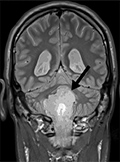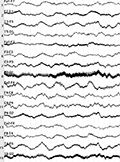The eLitMed.hu medical portal uses computer cookies for convenient operation. Detailed information can be found in the Cookie-policy.
Clinical Neuroscience - 2015;68(09-10)
Content
[Molecular pathology of meningiomas]
[Meningiomas represent nearly one-third of all adult primary brain tumours. According to their clinical and histologic appearance, they can be divided into WHO grades I-III. Almost 90% of meningiomas are benign, showing favourable response to conventional therapies, however, patients diagnosed with grade 2 and 3 tumours may have a poor prognosis. In addition, high frequency of tumour recurrence renders treatments more challenging even in benign meningiomas. Molecular-pathological profiling of meningiomas could lead to development of more effective therapies. Although the cytogenetic background of these tumours are already wellcharacterised, the majority of related genes and mutations is still unknown. Recently, high-throughput techniques enabled better characterisation of mechanisms involved in meningioma development, progression and recurrence. Furthermore, epigenetic dysregulation could offer new opportunities for both diagnosis and treatment of meningiomas. We provide a comprehensive overview of cytogenetic and molecular genetic defects as well as epigenetic alterations in meningiomas. Many of these may serve as biomarker or therapeutic target in the near future.]
[High prevalence of burnout and depression may increase the incidence of comorbidities among Hungarian nurses]
[Background and purpose - Poor mental health among health care professionals may have a significant impact on public health. There is limited information about the prevalence and potential consequences of burnout and depression among nurses in Hungary. The objective of this study is to explore the relationship between burnout as well as depression and somatic symptoms as well as comorbidities among nurses in Hungary. Methods - Cross-sectional study with self-administered questionnaires among 1,713 nurses. Burnout and depression were assessed by the Maslach Burnout Inventory (MBIHSS) and the Shortened Beck Depression Questionnaire, respectively. Somatisation was measured by the Patient Health Questionnaire (PHQ-15). Correlates of burnout and depression were assessed by logistic and linear regression analyses. Results - The prevalence of depressive symptom and clinical depression was 35% and 13%, respectively. The prevalence of moderate and high level emotional exhaustion, depersonalisation, and decreased personal accomplishment was 44%, 36% and 74%, respectively. We identified burnout and depression as a predictor of high prevalence of subjective somatisation. Whilst burnout showed a strong association with increased prevalence of hypertension, depression predicted almost all examined diseases, in particular, cardiac and cerebrovascular diseases, as well as neoplasms. Conclusion - We found high prevalence of burnout and depression among nurses in Hungary. As depression has been shown to be associated with higher prevalence of comorbidities than burnout, its consequences may be more significant. Appropriate prevention, diagnosis, and adequate treatment of burnout and depression may decrease the prevalence of ensuing comorbidities.]
Turkish version Quality of Life in Essential Tremor Questionnaire (QUEST): Validity and reliability study
Background - Our aim was to translate the Quality of Life in Essential Tremor Questionnaire (QUEST) advanced by Troster (2005) and to analyse the validity and reliability of this questionnaire. Methods - Two hundred twelve consecutive patients with essential tremor (ET) and forty-three control subjects were included in the study. Permission for the translation and validation of the QUEST scale was obtained. The translation was performed according to the guidelines provided by the publisher. After the translation, the final version of the scale was administered to both groups to determine its reliability and validity. Results - The QUEST Physical, Psychosocial, communication, Hobbies/leisure and Work/finance scores were 0.967, 0.968, 0.933, 0.964 and 0.925, respectively. There were good correlations between each of the QUEST scores that were indicative of good internal consistency. Additionally, we observed that all of the QUEST scores were most strongly related to the right and left arms (p=0.0001). However, we observed that all of the QUEST scores were weakly related to the voice, head and right leg (p=0.0001). Discussion - These findings support the notion that the Turkish version of the Quality of Life in Essential Tremor (QUEST) questionnaire is a valid and reliable tool for the assessment of the quality of life of patients with ET.
Anxiety management and functional magnetic resonance imaging - should it be a priority?
Background and purpose - Studies have shown that a high proportion of patients undergoing MRI examinations experience anxiety and distress which may compromise image quality and successful data acquisition. Research on fMRI related anxiety is limited as to date, therefore, the purpose of this study was to assess the changes in anxiety as well as to examine its interactions with the implementation of a dedicated patient preparation phase prior to the examination. Methods - An fMRI examination consisting of six paradigms was performed on nine female and nine male healthy volunteers. Prior to the examination, the volunteers were subject to an extensive patient preparation phase including the professional support of a psychologist. The volunteers were subject to the State Trait Anxiety Inventory (STAI) pre and post fMRI. Blood pressure and heart rate were also measured pre and post fMRI examination. Results - A high level of trait and state anxiety was observed (STAI-T: 41.67±8.96; STAI-S: 34.78±9.79) prior to the examination. The level of state anxiety decreased significantly following the examination (STAI-S: 28.83±4.99, p<0.01). Correlation between the volunteers level of anxiety prior to the fMRI scan and the volume of the activation areas was observed in the finger-tapping (r=0.656; 0.561) and word generation (r=0.471) paradigms. Conclusion - The results of this study support the contribution of a supportive patient preparation phase inclusive of professional guidance to help reduce the volunteers’ level of distress and anxiety. These results encourage the study to be extended to clinical patients.
Quality of life of patients with non-diabetic peripheral neuropathic pain; results from a cross-sectional survey in general practices in Hungary
Background and purpose - There is a lack of data on the impact on health related quality of life of peripheral neuropathic pain in Hungary. The main aims of the study were to assess the health related quality of life of nondiabetic PeNP patients identified in general practices through screening, and to assess the relationship between condition specific pain scores and health state utilities. Methods - Non-diabetic patients aged ≥30 years were recruited in 10 general practices in Hungary. At first, patients filled in the PainDETECT Questionnaire (PD-Q) and those who have achieved ≥13 PD-Q score (unclear or possible neuropathic pain) were further assessed by the DN4 questionnaire. Patients with PD-Q score >18 or DN4 score ≥4 were considered to have PeNP and they completed the EQ-5D health questionnaire. Results - Among the 111 patients identified as non-diabetic PeNP patients the mean age was 62 (SD=14) years, 69% were women. Average EQ-5D score was 44% lower than the gender and age matched Hungarian norm (0.42 vs. 0.75, p<0.001) and it worsened with increasing pain intensity. The pain/discomfort and anxiety/depression were the most affected EQ-5D dimensions. Strong relationship was demonstrated between the PD-Q and EQ- 5D score. Most of the PeNP patients (86%) were undiagnosed. Conclusions - Non-diabetic PeNP pain has a huge negative impact on health related quality of life. Although PeNP is a serious chronic condition, the disease burden is seriously underestimated, both on the level of individuals and society, due to the fact that patients are rarely identified.
Restless legs syndrome and insomnia frequency in patients with psoriasis
Background - To assess the prevalence and severity of RLS in psoriasis patients and to investigate its effects on sleep and quality of life. Methods - Seventy patients with psoriasis in Trakya University Medical Faculty Dermatology Department and also applied to Neurology Department in the same center and 70 volunteer controls were enrolled in the study. Severity of the Restless Legs Syndrome (RLS) was determined using International Restless Legs Syndrome Study Group (IRLSSG) criteria among the patients who have been diagnosed with RLS based on IRLSSG criteria. The presence of insomnia in patients was detected using International Classification of Sleep Disorders (ICSD-II) criteria. Additionally, to evaluate the severity of the disease and quality of life, Psoriasis Area Severity Index (PASI) and Dermatology Life Quality Index (DLQI) tests were applied to the patients with psoriasis. Results - RLS frequency in patients with psoriasis was 28 (40%) compared to the control group 10 (14.2%), and the difference was statistically significant (p<0.001). IRLSSG severity scores were higher in patients with psoriasis who had insomnia secondary to RLS compared to those who did not have insomnia (p<0.001). The mean values of PASI were 7.54±6.52 in the presence of insomnia and 3.27±2.69 in the absence of insomnia. The difference was statistically significant (p<0.001). No significant difference was found in DLQI scores between patients with RLS and without RLS or between patients with and without insomnia (p>0.05). Discussions - RLS frequency in patients with psoriasis was significantly higher than in the control group. In addition, we found that RLS is more common but RLS severity was mildly high in patients with psoriasis relative to controls. However, there was a correlation between the increase in severity of RLS with secondary insomnia patients who were diagnosed with RLS. It may be beneficial to consider RLS and insomnia for each patient diagnosed with psoriasis.
[Transient pseudobulbar syndrome in unilateral frontal opercular infarcts]
[The classic anterior (frontal) opercular syndrome (Foix- Chavany-Marie sy.) is a cortical pseudobulbar palsy mainly due to bilateral lesions of anterior brain operculum. In 2000 the authors had a 70-year old female patient with acute onset of swallowing and speaking difficulty. Neurological examination established a left facial central palsy, the palsy of the tongue and the soft palate, dysarthry, difficulty in chewing with left side hemiparesis. The CT scan showed a right side (one-sided) frontal opercular ischemic lesion. This event switched their attention especially to this group of cases and subsequently the authors collected 12 patients with these symptoms. Authors discuss the patomechanism of transient pseudobulbar palsy that occurs due to unilateral opercular lesion that the diaschisis effect might explain.]
Multimodal quantitative characterization of intracranial epidermoid cysts: preliminary results
Background and purpose - The differentiation of epidermoid cysts from other intracranial lesions with CT and conventional MR imaging is challenging. The risk of residual and recurrent disease is high and multimodal imaging should therefore promote a precise differential diagnosis. Since epidermoid cysts are histologically identical to middle ear cholesteatomas, MRI methods that are useful in the diagnosis of cholesteatoma; specifically EPI DWI and a non- EPI diffusion subtype (HASTE DWI) may possibly be applicable to epidermoid cysts. Besides testing the diagnostic utility of these methods on epidermoid cysts, our goal was to quantify the T1 and T2 relaxation times, the ADC values and the magnetization transfer ratios in order to acquire objective, characteristic information about their structure and contents. Finally, our goal was to provide the physician with a reliable, multimodal diagnostic tool that supports accurate surgical planning. Methods - Two patients with epidermoid cysts were examined. Besides the conventional MR scans EPI DWI, HASTE DWI, quantitative T1, T2 and magnetization transfer measurements were performed mappingwith a 3T MR scanner. After image registration, T1, T2 relaxation times and the magnetization transfer ratio inside a ROI were determined according to the lesion location on HASTE DWI. Mean ADC values inside the epidermoid cysts were also calculated by both mono-exponential and bi-exponential diffusion models. Results - Our results revealed relatively high T1 and T2 relaxation times and ADC values, and low magnetization transfer ratios in both subjects. Conclusion - HASTE-DW MRI provides accurate morphologic information on epidermoid cysts, while T1, T2, ADC and magnetization transfer ratio maps are quantitative techniques. Thus the combination of these methods results in a confident preoperative diagnosis and aids to determine the indication of retreatment in the event of recurrence.
Extreme delta brush EEG pattern in a case with anti-NMDA receptor encephalitis
Anti-N-methyl-D-aspartate receptor NMDA-R encephalitis is caused by antibodies against the NMDA-R and characterized by a severe encephalopathy with psychosis, epileptic seizures and autonomic disturbances. This disorder is often accompanied with malignancies, especially ovarian teratoma. Some patients’ EEGs show a different pattern similar to the waveforms of premature infants and this pattern is specifically named as extreme delta brush (EDB). We report a 24-year-old female having anti-NMDA receptor encephalitis and EDB patern.
1.
Clinical Neuroscience
[Headache registry in Szeged: Experiences regarding to migraine patients]2.
Clinical Neuroscience
[The new target population of stroke awareness campaign: Kindergarten students ]3.
Clinical Neuroscience
Is there any difference in mortality rates of atrial fibrillation detected before or after ischemic stroke?4.
Clinical Neuroscience
Factors influencing the level of stigma in Parkinson’s disease in western Turkey5.
Clinical Neuroscience
[The effects of demographic and clinical factors on the severity of poststroke aphasia]1.
2.
3.
4.
5.











